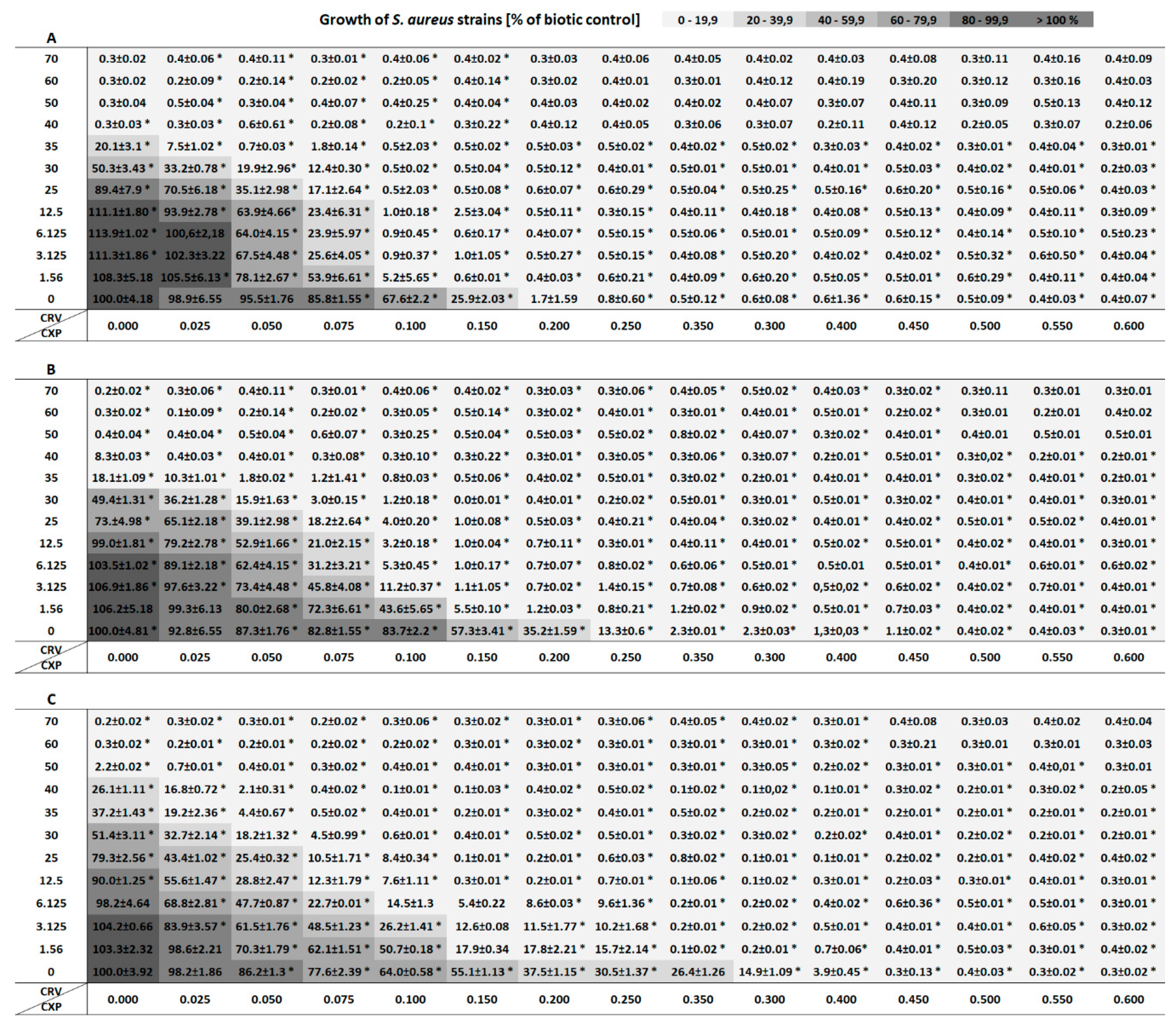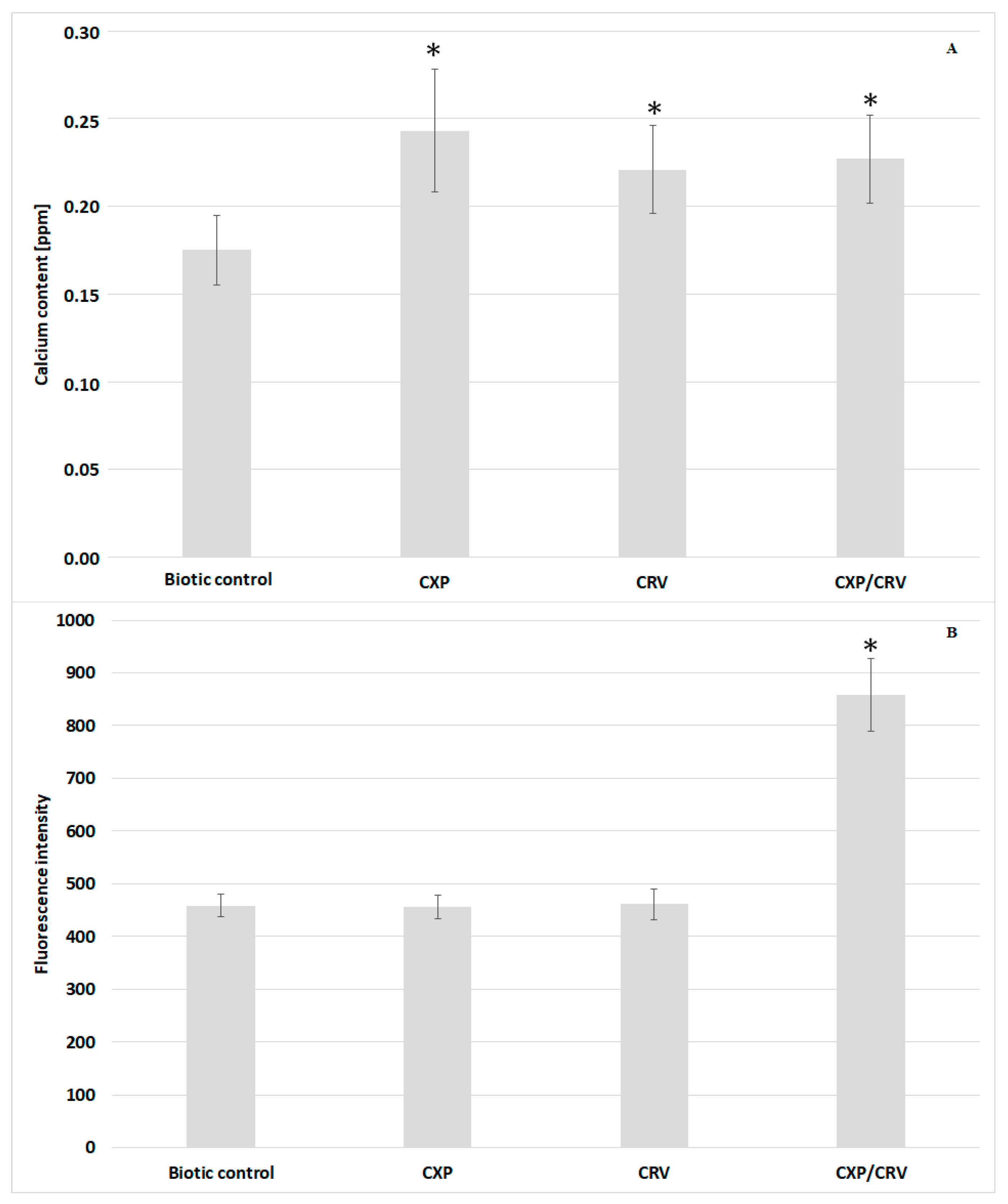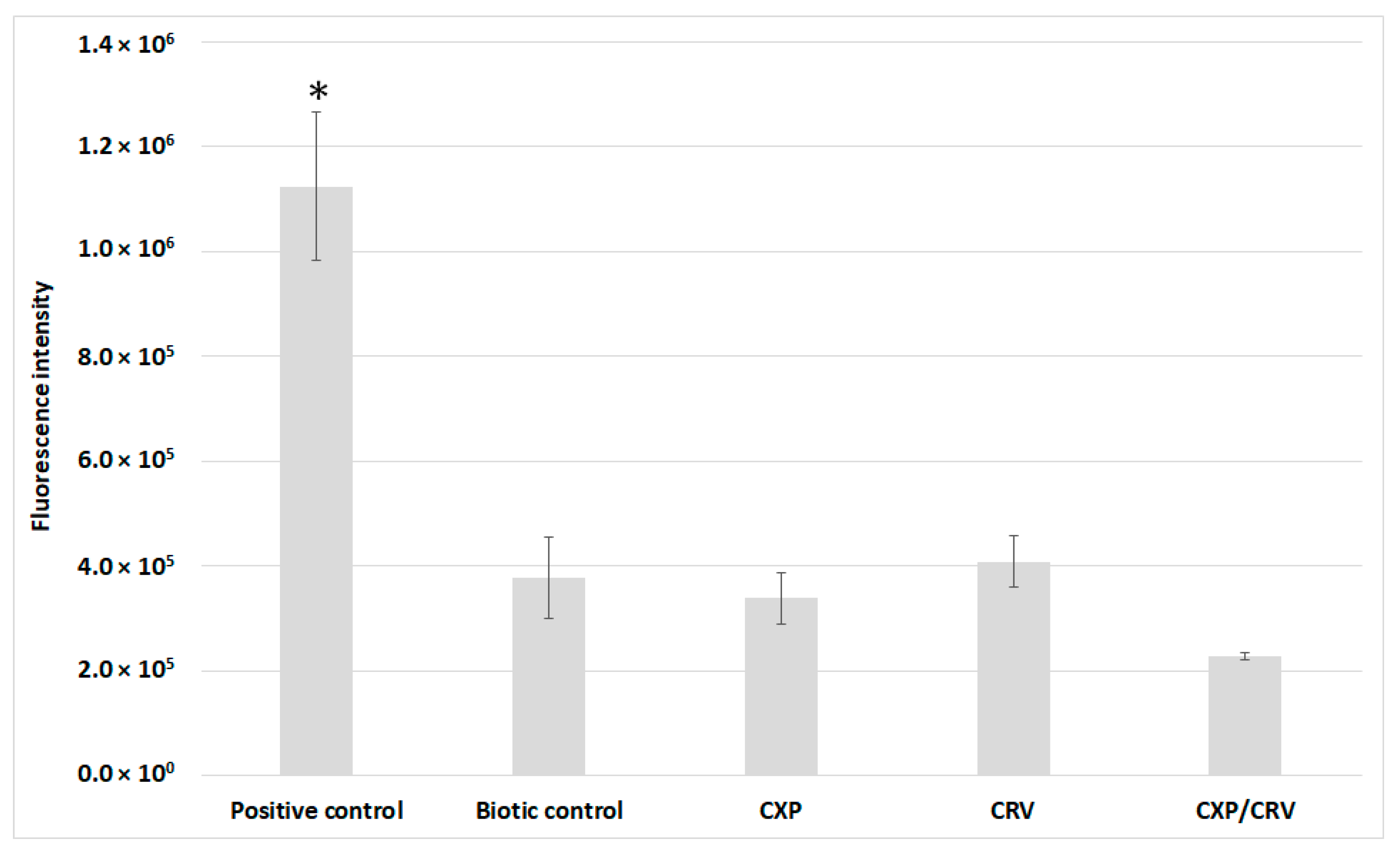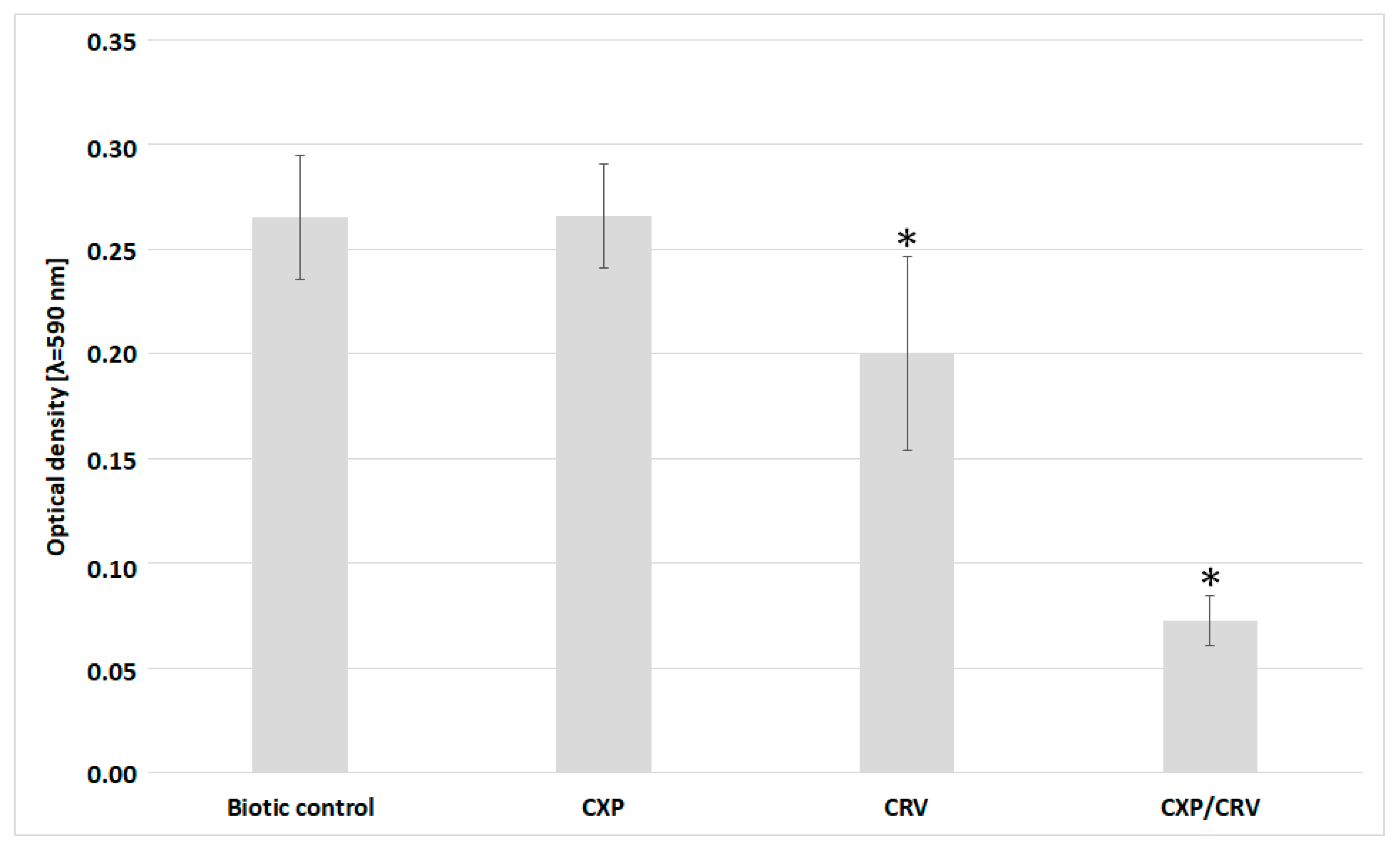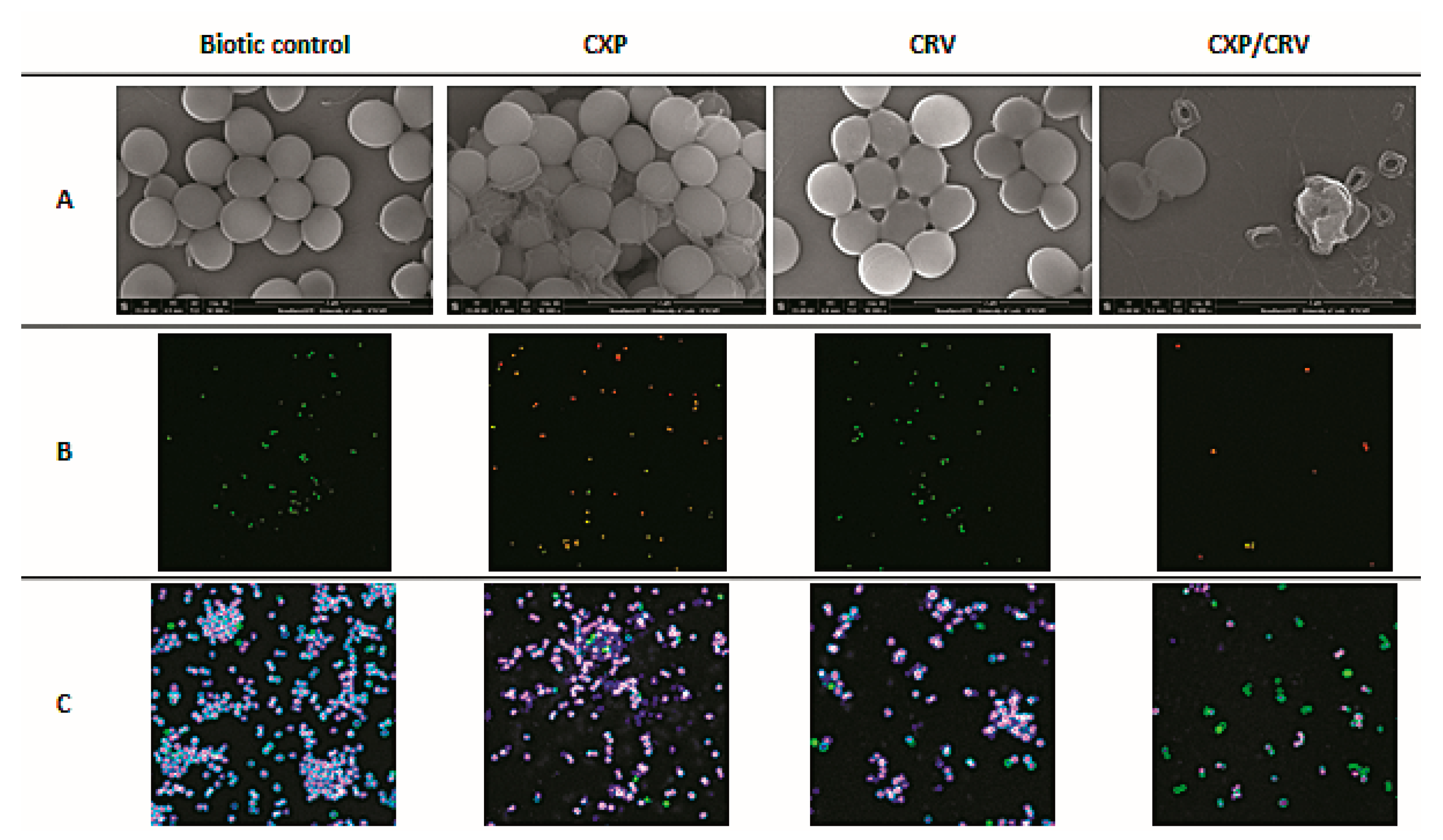1. Introduction
Staphylococcus aureus is one of the most common human commensal microorganisms; however, it causes numerous opportunistic infections.
S. aureus possesses an ability to evade the response of the immune system and can colonize many niches within the host organism [
1,
2,
3]. In addition, it is a pathogen causing bacteremia and infections such as in the endocardium, skin and soft tissue, or in osteoarticular systems [
3]. The wide range of
S. aureus virulence factors and the spread of antibiotic resistance of the bacteria make these infections difficult to treat.
S. aureus is responsible for infection in approximately 1% of all patients admitted to hospitals in the United States, and the cost of their treatment is estimated at 9.5 billion dollars per year [
1].
A serious problem for healthcare is the development of drug resistance in staphylococci. For example,
S. aureus strains resistant to penicillin were isolated shortly after the introduction of the drug. The bacteria produce enzymes, such as β-lactamase, which can hydrolyze bonds in antibiotic structures and reduce their antibacterial activity. The chemical modifications of naturally occurring penicillin have been of little avail because the resistance of
S. aureus strains toward methicillin or oxacillin is frequently noted [
4]. An increasing frequency of infection caused by methicillin-resistant
S. aureus strains in recent years is especially worrying [
3].
One of the main problems in modern medicine is expanding bacterial resistance to conventional antimicrobial agents and hence a reduction in the effectiveness of infectious disease treatment [
5]. However, the search for/the development of new antimicrobial drugs can be a solution to this problem. Chauhan et al. [
5] demonstrated strong antibacterial activities of novel benzimidazole derivatives against
S. aureus. Gatadi et al. [
6] synthesized new benzamide and 4-oxoquinazolin-3(4H)-yl)benzoic acid derivatives, which showed inhibitory activity against
S. aureus as well. By contrast, derivatives of 4(3H)-quinazolinones and 1,2,3-triazole possess antimicrobial potential against multidrug-resistant
S. aureus strains [
7]. The simultaneous application of different antibiotics can be also an effective approach in the treatment of bacterial infections. Moreover, combination therapy is proposed as a potential strategy to fight drug-resistant bacteria [
8].
An alternative to combination therapy with various antibiotics seems to be the use of the antimicrobial potential of non-antibiotic drugs [
9]. Mazumdar et al. [
10] studied ten cardiovascular drugs in terms of their antimicrobial activity and the highest potency was shown by oxyfedrine.
In our previous report, the antibacterial activity of high concentrations of carvedilol against Gram-positive and Gram-negative bacteria was described [
9]. Carvedilol is a nonselective beta-adrenergic receptor blocking agent that also shows antioxidant and Ca
2+ channel blocking activity [
9]. Here, we report on the synergistic effect of ciprofloxacin and carvedilol against
S. aureus strains including MRSA. Furthermore, the results of SEM and confocal imaging as well as calcium ion content in bacterial cells and biofilm formation were evaluated to explain the mechanism of antimicrobial synergy between ciprofloxacin and carvedilol.
3. Discussion
Literature data on the antimicrobial properties of carbazole derivatives, such as carvedilol, are still limited. To date, the moderate antibacterial potential of carbazolyl glyoxamides or β-carboline chalcones against Gram-negative and Gram-positive bacteria has been demonstrated [
11,
12]. Our previous studies have shown the antimicrobial potential of carvedilol at high concentrations against Gram-positive bacteria [
9]. The minimum inhibitory concentrations (MICs) of the β-blocker for
S. aureus and
S. pyogenes were 40 and 45 mg/L, respectively. Moreover, changes in the fatty acid profile and an increase in membrane permeability were detected both in Gram-negative and Gram-positive bacteria [
9]. In the light of these reports, the presented results regarding the synergy of ciprofloxacin and carvedilol seem valuable as a potential new alternative strategy of infectious disease treatment. However, further in vivo studies and an explanation of the mechanism of synergistic interaction of the tested compounds are needed.
Calcium is one of the most important cell regulators in eukaryotes, but its role in prokaryotic cells is not yet well understood. However, it was found that bacterial cells maintain calcium homeostasis due to membrane ion channels, transporters, and calcium-binding proteins. Calcium ions are probably engaged in cell structure maintenance, the motility of bacterial cells, the expression of genes, and cell division and their differentiation. It has also been shown that changes in the level of free Ca
2+ ions can be a signal mechanism [
13]. In the case of carvedilol and ciprofloxacin, the calcium channel blocking activity has been stated [
6,
14]. Therefore, the studies of the mechanism of the synergistic action of ciprofloxacin and carvedilol included the analysis of calcium content in
S. aureus cells untreated and treated alone and in combination with the tested compound. Although both tested compounds show calcium channel blocker activity, an increase in the free Ca
2+ level was observed in
S. aureus cells incubated simultaneously with the antibiotic and the β-blocker, while total calcium content was similar in all tested samples. The observed effect might be a result of the interaction of ciprofloxacin with carvedilol and as a consequence formation of a new complex with a stronger antimicrobial effect than the drugs using separately.
The changes in the calcium level in eukaryotic cells are related to the production of reactive oxygen species (ROS) and the initiation of the pathways of cell death such as necrosis or apoptosis [
15]. However, in the present study, induction of reactive oxygen species formation was not demonstrated after the treatment of
S. aureus cells with ciprofloxacin and carvedilol. Therefore, no correlation was found between the increase in calcium ion concentration and the induction of ROS synthesis.
The enhancement of the antimicrobial potential of ciprofloxacin by carvedilol may have been the result of the release of a certain pool of bound calcium. In our previous studies, the modifications of the profile of fatty acids of
S. aureus cells incubated with carvedilol were shown. These results were also correlated with changes in bacterial membrane permeability [
9]. Thus, the release of calcium into the cytosol seems to be possible as a result of destabilization of the cell envelopes. However, in this study, an increase in bacterial membrane permeability was demonstrated in all samples incubated with ciprofloxacin.
Calcium ions can be also engaged in the aggregation of bacterial cells and consequently biofilm formation [
16,
17]. Pathogens, such as
S. aureus, may possess an ability to form biofilm structures on abiotic and biotic surfaces that can protect bacteria against the response of the host immune system and against the action of antibacterial agents [
18]. The obtained results showed the reduction of
S. aureus biofilm formation after the simultaneous treatment with ciprofloxacin and carvedilol, which was correlated with an increase in the level of free Ca
2+ inside the bacterial cells. Moreover, SEM analysis demonstrated formation of specific cell clusters in samples incubated with the antibiotic alone. Watters et al. [
19] also showed the ability of
S. aureus to form similar network-like structures in biofilms. Habber et al. [
16] detected cellular aggregates formed in
S. aureus cultures whose matrix was built of polysaccharide intercellular adhesin (PIA). Bacterial aggregates may contain matrix components such as surface proteins, polysaccharides, or extracellular DNA (eDNA). Protein A-, fibrinogen-, and fibronectin-binding proteins are involved in staphylococcal biofilm formation at an early stage of the process. The next important component of the biofilm matrix can be extracellular polysaccharides (EPSs) such as poly-
N-acetyl-β-(1,6)-glucosamine. Extracellular DNA, which is a key factor for early biofilm formation, is released during controlled bacterial cell lysis [
16]. In addition, the protective role of bacterial aggregates and their contribution to increasing the tolerance of pathogens to antibiotics was indicated [
20]. Therefore, the contribution of eDNA to the formation of aggregates of
S. aureus cells treated with ciprofloxacin and carvedilol was also assessed. The participation of eDNA in the formation of bacterial aggregates was confirmed in samples incubated separately with the addition of the antibiotic and carvedilol. Moreover, microscopic analysis of
S. aureus cells incubated without and with the addition of ciprofloxacin and/or carvedilol revealed significantly less bacterial cell clusters formed in cultures supplemented simultaneously with both tested compounds. The obtained results suggest a possible negative impact of both tested compounds added simultaneously to
S. aureus cultures on the ability of bacteria to form cell clusters, which might have prevented
S. aureus cell growth.
Although ciprofloxacin causes many side effects, it is still one of the most commonly used fluoroquinolone antibiotics. Application of ciprofloxacin commonly leads to the reactions of the central nervous system and the digestive system including vomiting, nausea, diarrhea, sleeplessness, dizziness, or headache. Moreover, tendon rupture, muscle weakness, and joint inflammation were observed in patients treated with ciprofloxacin [
21,
22]. The side effects of the tested β-blocker are similar to those caused by ciprofloxacin, such as nausea, vomiting, and diarrhea. Edema, bradycardia, hypotension, and blurred vision are also frequently noted in patients cured with the antibiotic [
23]. The occurrence of similar side effects in therapy with both compounds may be a problem in clinical use; therefore, further in vivo experiments are required.
4. Materials and Methods
4.1. Standards and Reagents
Carvedilol (PHR1265) and ciprofloxacin (17850) were purchased from Sigma-Aldrich (Poznań, Poland). Cation-adjusted Mueller Hinton II Broth (MHB) was obtained from Becton Dickinson (Warsaw, Poland). Fluo 3-AM and a LIVE/DEADTM BacLightTM Bacterial Viability Kit were purchased from Thermo Fisher Scientific (Warsaw, Poland). Glutaraldehyde and osmium tetroxide were obtained from Agar Scientific (Stansted, UK). All of the other reagents with a high analytical purity grade were obtained from Sigma-Aldrich (Poznań, Poland).
4.2. Carvedilol and Ciprofloxacin Susceptibility Testing
The antibacterial potential of ciprofloxacin (CXP) and carvedilol (CRV) was tested by the microdilution method in Mueller Hinton Broth (MHB) according to CLSI and EUCAST guidelines. Susceptibility testing assays were conducted on S. aureus ATCC 6538, S. aureus ATCC 29213, and S. aureus ATCC 43300 in 96-well cell culture plates. The antibacterial activity of CXP and CRV were assessed over concentration ranges of 0.025–0.6 mg/L and 1.56–70 mg/L, respectively. The stock solutions of CRV and CXP at the concentration 25 mg/mL were prepared in dimethyl sulfoxide and deionized water with the addition of 0.1 M HCl, respectively. The CRV and CXP solutions were then diluted in MHB to achieve the final tested concentrations and to minimize the effect of solvents on the bacterial growth. A final bacterial density in each well was 5 × 105 CFU/mL. Samples containing CRV and/or CXP as well as adequate abiotic and biotic controls were incubated for 24 h at 37 °C. The optical density of all tested combinations was measured spectrophotometrically (λ = 630 nm) using a MultiskanTM FC Microplate Photometer (Thermo Fisher Scientific). The results of bacterial susceptibility are shown as a percentage of the control group (n = 4) from four separate experiments.
The minimum inhibitory concentration (MIC) was designed as the lowest concentration of ciprofloxacin or carvedilol that inhibited the growth of 99% microorganisms. The fractional inhibitory concentration (FIC) of ciprofloxacin or carvedilol was calculated from the formulas:
The fractional inhibitory concentration index (FICI) of the tested drugs was calculated from the formula:
FICI ≤ 0.5 was defined as synergy [
24].
4.3. Assay of Calcium Content in the Bacterial Cells
The calcium content in S. aureus cells incubated with and without the addition of CRV and/or CXP was measured using flow cytometry and atomic absorption spectroscopy. The bacterial cells were centrifuged at 10,000 rpm for 4 min and washed thrice with phosphate buffered saline (PBS). A part of the S. aureus cells was suspended in a Fluo 3-AM solution prepared in PBS and incubated at 37 °C for 60 min in the dark. Then, bacterial cells were centrifuged at 10,000 rpm for 4 min and washed thrice with PBS. Finally, bacteria were suspended in 500 µL PBS and analyzed on an LSR II (Becton Dickinson, San Jose, CA, USA) instrument by acquiring 30,000 events per sample. Untreated S. aureus cells were used as the control. The fluorescence of a Fluo 3-AM stain was excited by an argon-ion laser at 488 nm and collected at 530 nm. All experiments were prepared in triplicate in two independent tests. The calcium ion content in S. aureus cells was expressed as the median of the histogram fluorescence intensity of Fluo 3-AM.
The second part of the bacterial cells was washed away from the MHB medium and filled with 5 mL of nitric acid and mineralized at 148 °C for 4 h. Each sample was diluted five times in deionized water and the calcium concentration was measured using a Varian SpectrAA 300 Flame Atomic Absorption Spectrophotometer (Varian, Palo Alto, CA, USA).
The experiments were carried out in four independent repetitions.
4.4. ROS Production Measurement
ROS production was measured in S. aureus cells untreated and treated with CXP and/or CRV for 30 min using the CM-H2DCFDA reagent according to the producer’s protocol. Bacterial cells incubated with H2O2 at a concentration of 100 µM for 30 min were used as a positive control. After 30 min incubation with the tested compounds, the S. aureus cells were centrifuged at 10,000 rpm for 4 min and washed thrice with phosphate buffered saline (PBS). Then, the bacterial cells were suspended in a CM-H2DCFDA solution at a concentration of 5 µM and incubated at 37 °C for 30 min in the dark. Next, the cells were again centrifuged at 10,000 rpm for 4 min and washed with PBS. The fluorescence intensity was measured at the excitation/emission (ex/em) maxima, 495/520 nm, using a SpectraMax i3x Multi-Mode Microplate Reader (Molecular Devices Ltd, Wokingham Berkshire/UK). The experiment was carried out in three independent repetitions.
4.5. Biofilm Formation Measurement
Biofilm formation was evaluated in 96-well cell culture plates similarly to CRV and CXP susceptibility testing. After 24 h of incubation, the bacterial suspensions with and without CRV and/or CXP were removed from the wells. Then, each well was washed twice with 0.9% NaCl and stained with a 0.1% crystal violet solution prepared in 0.9% NaCl. Next, the wells were washed with deionized water and dried at 37 °C for 30 min. Finally, the wells were washed with 80% ethanol and deionized water. The absorbance was measured at 590 nm. The experiment was carried out in four independent repetitions.
4.6. Confocal Microscopy
Cell visualization was conducted in the Laboratory of Microscopic Imaging and Specialized Biological Techniques (Faculty of Biology and Environmental Protection, University of Lodz) using a Leica TCS SP8 microscope equipped with plan achromatic objectives (Leica) and with magnifications of 63× (Water immersion) and 100× (Oil immersion).
S. aureus cells were stained using the LIVE/DEADTM BacLightTM Bacterial Viability Kit according to the producer’s protocol. The bacterial cells treated and untreated with CXP and/or CRV were centrifuged at 10,000 rpm for 4 min and washed thrice with PBS. Then, the cells were suspended in 100 µL PBS with the addition of 1 µL of the Syto 9 and propidium iodide mixture (v/v:1/1). Next, the bacterial suspensions were vortexed and incubated at 37 °C for 15 min in the dark. Finally, the fluorescence of Syto 9 and propidium iodide was measured at the excitation/emission (ex/em) maxima of 480/500 nm and 490/635 nm, respectively.
The bacterial cells were also stained with the Alexa Fluor 488 and the Syto 59 dyes according to the producer’s protocol. S. aureus cells were separated from the growth medium and washed thrice with PBS and then suspended in 150 µL Alexa Fluor 488 and Syto 59 solution at the concentrations of 0.3 and 0.02 µM, respectively. The bacterial cells were incubated at 37 °C for 30 min in the dark and then centrifuged at 10,000 rpm for 4 min and washed thrice with PBS. Next, the fluorescence of the Alexa Fluor 488 was detected at the (ex/em) maxima of 495/519 nm and 490/635 nm. Finally, the Syto 59 fluorescence was visualized at the (ex/em) maxima of 622/640-660 nm and 622/660-720 nm. The experiments were carried out in three independent repetitions.
4.7. Scanning Electron Microscopy
S. aureus cultures incubated with and without CXP, CRV, or CXP/CRV were centrifuged at 10,000 rpm for 4 min and washed thrice with PBS. Next, the bacterial cells were suspended in a glutaraldehyde solution and incubated for 16 h. After incubation, S. aureus cells were again centrifuged at 10,000 rpm for 4 min and washed thrice with PBS. The obtained precipitates were suspended in an osmium tetroxide solution and incubated for 20 min. Next, the bacterial suspensions were centrifuged and washed in PBS and then dehydrated in a series of ethanol solutions (25%, 50%, 75%, 90%, and 100%) for 15 min each. S. aureus cells were spread on a silicon wafer, dried at room temperature and sputtered with an Au layer at a thickness of 2 nm. SEM images of the treated and untreated S. aureus cells were performed using a Nova NanoSEM™ scanning electron microscope. The images were made in an immersion mode using a through lens detector (TLD) at a typical magnification of 50,000×. The experiment was carried out in three independent repetitions.
4.8. Statistical Analysis
All experiments were at least performed in triplicate. The obtained values were expressed as the means with standard deviation (SD). The one-way and two-way analyses of variance (ANOVA) with p < 0.05 were considered statistically significant calculations using Excel, Microsoft ® Office 2016 (Microsoft Corporation, Redmond, WA, USA).
